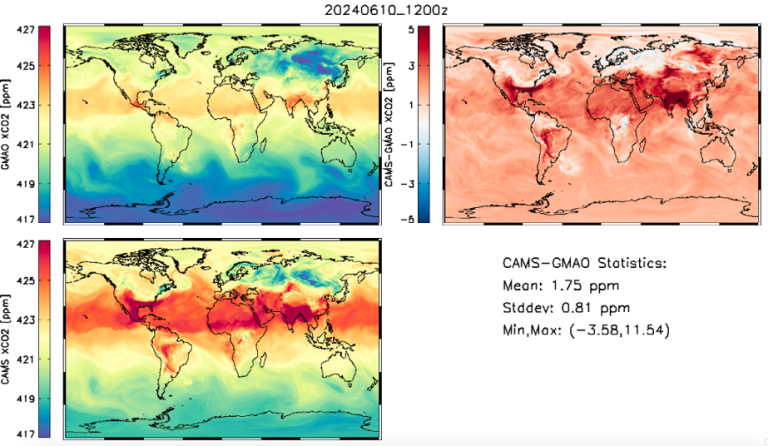Dr. Lesley Ott, a research meteorologist at NASA's Global Modeling and Assimilation Office (GMAO), leads the agency's carbon cycle modeling efforts and serves as project scientist for the U.S. Greenhouse Gas (GHG) Center.
A career at the crossroads of climate and computation
For Dr. Ott, the complexity of greenhouse gases is fascinating as carbon dioxide, methane, and nitrous oxide interact with nearly every part of the Earth system, from human activity and land use to ocean dynamics and atmospheric circulation. This makes their behavior both difficult and rewarding to study. At NASA, Ott works across disciplines, integrating satellite observations, numerical weather prediction, and carbon-cycle science to improve global models and produce actionable information.
Rapid progress in modeling and observations
Dr. Ott highlights a decade of remarkable growth in the field. Improvements in satellite missions such as NASA's Orbiting Carbon Observatory (OCO) have delivered denser and higher-quality data, reducing early biases between land and ocean measurements. Parallel advances in data assimilation techniques-methods for combining model output with observations- now allow GHG information to be integrated into operational forecasting systems. These systems, once confined to research, are increasingly capable of producing near-real-time estimates of greenhouse gas fluxes at finer spatial scales, a crucial step for city- or state-level climate action.

Key breakthroughs include:
- Better prior information: More accurate emissions inventories and terrestrial and oceanic carbon models provide stronger starting points for atmospheric inversions.
- Operational integration: Embedding GHG tracking within large-scale weather and climate models enables higher resolution and faster data delivery.
- Adaptive numerical methods: Emerging "hybrid grids" enable modelers to concentrate computational power where emissions are dense - urban areas or energy production zones - while reducing effort in less active regions.
Persistent scientific challenges
Despite these advances, Dr. Ott stresses that GHG modeling remains one of the hardest problems in Earth science. Extremely small atmospheric gradients demand precision at the limits of computational accuracy. Interpreting concentration changes requires disentangling signals from land, ocean, and human sources. Methane, for example, has numerous small, scattered emitters, making it difficult to track, while nitrous oxide suffers from sparse observations altogether.
Vertical transport processes - boundary-layer mixing and convection - add further uncertainty, especially for carbon dioxide. Dr. Ott calls for more vertically resolved aircraft profiles and expanded ground-based networks to validate satellite data and improve model physics. Independent validation, she argues, is critical to ensure that models are getting the right answer for the right reason.
Getting the right answer for the right reason." - Dr. Ott
Collaboration and open access resonate with the G3W's efforts
Ott views international cooperation as essential. Initiatives like G3W foster collaboration between modelers, observational networks, and national agencies, creating international standards for evaluating models and sharing data. She cites the establishment of near-real-time GHG products and a commitment to open, publicly accessible datasets as key measures of success.
In this context, progress achieved by the Task Team on Modelling (TT-G3W-Modelling) is crucial because it transforms GHG modeling from a research activity into an operational, decision-supporting system. By defining common standards, improving data assimilation techniques, and advancing high-resolution modeling, TT-G3W-Modelling enables participating centers to generate consistent, near-real-time estimates of GHG fluxes and concentrations. These advances reduce uncertainties, enhance the integration of satellite and ground observations, and provide reliable and comparable information for WMO Member countries. Toward a sustainable future
Looking ahead, Dr. Ott envisions modeling centers playing a dual role: supporting mitigation by precisely tracking emissions and informing adaptation by producing short-term climate projections. She advocates closer integration between GHG modeling and near-term climate prediction, providing stakeholders with actionable information on 10- to 30-year timescales - crucial for financial planning and infrastructure development.
For Dr. Ott, the ultimate goal is to bridge research and operations so that GHG models not only advance scientific understanding but also guide real-world decisions. Climate change is not a 70- to 100-year problem, it's a now problem
Climate change is not a 70- to 100-year problem, it's a now problem." - Dr Ott
By combining cutting-edge observations, rigorous modeling, and open collaboration, NASA and its partners aim to deliver the trusted, high-resolution data that G3W, decision makers and communities need to act.






